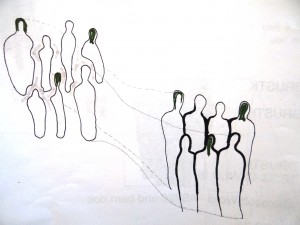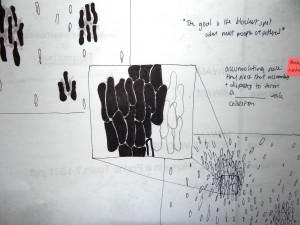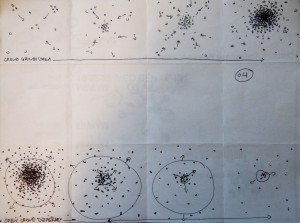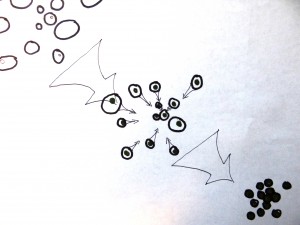




[The thing about I is, it only exists within a tenth-of-a-second of all its parts…when the neural architecture diffuses past some critical point and signals take just that much longer to pass from A to B— the system, well, decoheres…I shatters into we. It’s not just a human rule, or a mammal rule, or even an Earthly one. It’s a rule for any circuit that processes information, and it applies as much to the things we’ve yet to meet as it did to those we left behind.]
The Island, Peter Watts, page 14
Upon reading The Island by peter watts what really began to fascinate me is the idea of coherence and decoherence and the state at which one entity becomes two or vice versa. When is a complex system of parts a cohesive “I” and when it is a system of separate “I’s”? For example, if you take a system and spread it out, when does the communication time become long enough that one becomes two and what impact does this question have on the process of form-making?
According to the Merriam Webster dictionary, coherence has two distinct definitions. The first, as we normally think of coherence, is to hold together, firmly as parts of the same mass, becoming united in principles, relationships, or interests. The second definition relates to Quantum Coherence, which says that as long as all original possibilities of a system remain intact, the system is coherent, but when affected by an outside force, the system must choose which of the possibilities is true and therefore decoheres. The idea of “parts of the same mass” supports the question I brought up earlier “if you take a system and spread it out, when does the communication time become long enough that one becomes two?” but also triggered me to question what forms the cohesion in the first place, and does the amassing of parts have a limit? Can so many parts try to be of the same mass that it can no longer be one entity, but one mass that has two identities?
Focusing on the first definition, and the idea of massing and unmassing defining the coherency of an “I”, began to examine Elias Canetti’s Crowds and Power, and pulled some paragraphs for sketching ideas. The book focuses on crowds of people, but the rules and logics he pulls from the crowds of people could also apply to other material systems.
[2] “It is only in a crowd that man can become free of this fear of being touched. That is the only situation in which the fear changes into its opposite. The crowd he needs is the dense crowd, in which body is pressed to body; a crowd too whose psychical constitution is also dense, or compact, so that he no longer notices who it is that presses against him. As soon as a man has surrendered himself to the crowd, he ceases to fear its touch. Ideally, all are equal there; no distinctions count, not even that of sex. The man pressed against him is the same as himself. He feels him as he feels himself. Suddenly it is as though everything were happening in one and the same body.” –Elias Canetti, Crowds and Power
[3] “The crowd, suddenly there where there was nothing before, is a mysterious and universal phenomenon. A few people may have been standing together-five, ten, or twelve, not more; nothing has been announced, nothing is expected. Suddenly everywhere is black with people and more come streaming from all sides as though streets had only one direction. Most of them do not know what has happened and, if questioned, have no answer; but they hurry to be there where most other people are. There is determination in their movement which is quite different from the expression of ordinary curiosity. It seems as though movement of some of them transmits itself to the others. But that is not all; they have a goal which is there before they can find words for it. The goal is the blackest spot where people are gathered.” –Elias Canetti, Crowds and Power
[4] “For just as suddenly as it originates, the crowd disintegrates. In its spontaneous form is a sensitive thing. The openness which enables it to grow is, at the same time, its danger. A foreboding of threatening disintegration is always alive in the crowd. It seeks through rapid increase, to avoid this for as long as it can; it absorbs everyone, and, because it does, must ultimately fall to pieces.” –Elias Canetti, Crowds and Power
[6]” Only together can men free themselves from their burdens of distance; and this, precisely, is what happens in a crowd. During the discharge distinctions are thrown off and all fell equal. In that density where there is scarcely any space between, and body presses against body, each man is as near the other as he is to himself; and an immense feeling of relief ensues. It is for the sake of this blessed moment, when no-one is greater or better than another, that people become a crowd.” –Elias Canetti, Crowds and Power
The idea of the crowd in relation to architecture brings up the question of scale. I think it would be interesting to explore the idea of crowd accumulation at an architectural scale (how do many tiny pieces “crowd together” into a building?). It also brings up the idea of a larger, social/city scale, how do multiple organisms for one identity and create a city. How does this city spawn itself on a planetary scale or how does it become so dense that it splits into multiple “I’s”?